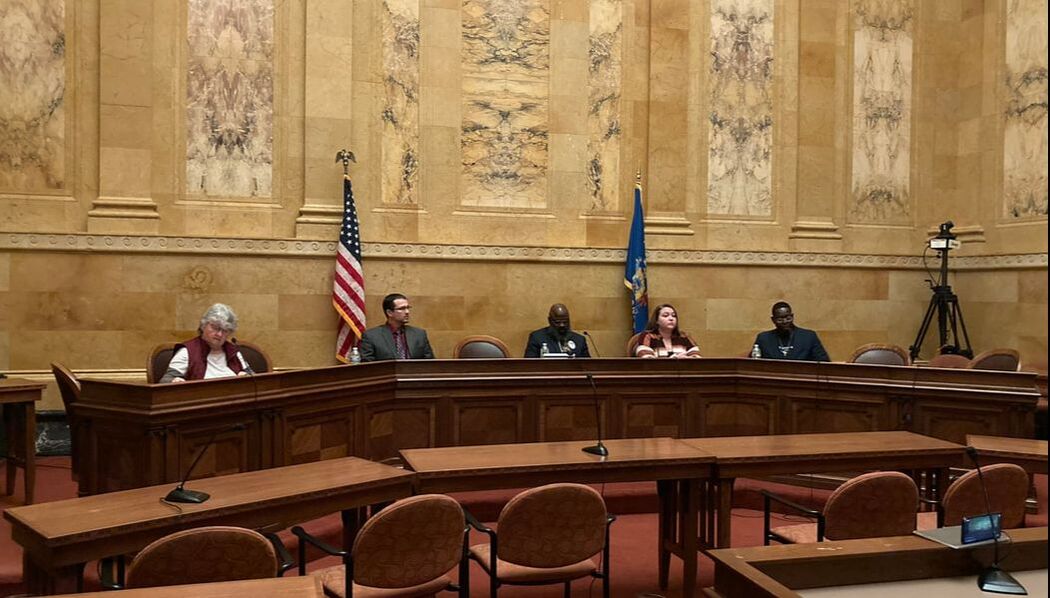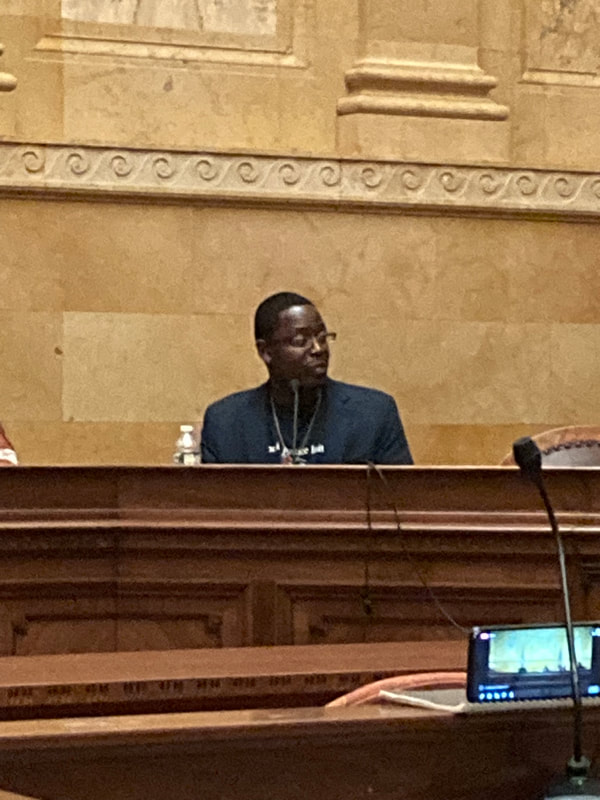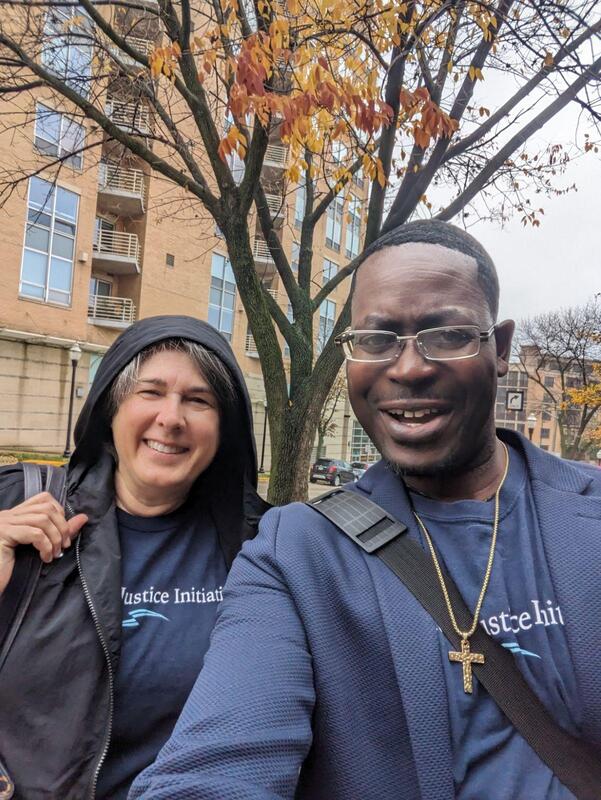|
By Margo Kirchner
Several organizations and activists this morning called on Wisconsin legislators and the governor to return 17-year-olds to the juvenile justice system and ensure that no 10-year-olds are eligible for the adult criminal justice system. The call came at a press conference outside the Milwaukee County Courthouse organized by Rev. Joseph Ellwanger on behalf of the Milwaukee Inner-city Congregations Allied for Hope (MICAH) Transformational Justice Task Force. Ellwanger was surrounded by more than two dozen supporters of youth justice reform, including two representatives from Wisconsin Justice Initiative. Ellwanger noted that the press conference was motivated by upcoming hearings in the case of a young boy who killed his mother when he was 10 years old. Under Wisconsin law, anyone charged with first degree intentional homicide, even a 10-year-old, is charged as an adult. (WJI guest columnist Roy Rogers previously wrote about the case here.) Hearings for a "reverse waiver" to juvenile court are set for next week in the young boy's case. Several speakers at the press conference referenced research indicating that the human brain does not fully develop until around age 25. Joshua Rovner of The Sentencing Project flew in from Washington, D.C. for the press conference. He noted that Wisconsin is one of only four states that treat all 17-year-olds as adults in the criminal justice system. (Wisconsin is aligned with Georgia, Texas, and Louisiana on that point.) Similarly, Wisconsin is one of just three states that allows a child as young as 10 years old to be charged as an adult for certain crimes, he said. Regarding the pending case, Rovner emphasized that “this is an elementary school child we are talking about.” Wisconsin’s Legislature and governor need “to fix these laws,” Rovner said. Emily Coddington, associate director of the Wisconsin Association of Family and Children’s Agencies, read a statement on behalf of the Raise the Age Coalition, a group of more than two dozen nonprofit and advocacy organizations pushing for legislation returning 17-year-olds to the juvenile justice system. “Wisconsin has failed to acknowledge what 46 other states already know: that raising the age (of adult prosecution) lowers recidivism rates, responds to often neglected mental health concerns and cognitive development research, provides a restorative and rehabilitative lens to youth justice, and begins to address racial disparities in the criminal justice system,” Coddington said. “We know that youth incarcerated with adults are 34% more likely to commit future crimes than youth served in settings designed to meet their unique needs, yet we continue to charge all 17-year-olds as adults,” she said. Wendy Volz Daniels, a clinical social worker and chair of the Felmers Chaney Advocacy Board, discussed how adults held by the Department of Corrections do not receive important anger management and cognitive behavior treatment until shortly before release. Several thousand individuals are on waiting lists for substance abuse and cognitive behavior treatment. “Sending children to the adult criminal justice system ensures that they will not get the treatment and rehabilitation that is needed,” she said. “Children cannot wait,” Daniels said. “Their needs are better served in the juvenile justice system, where they will immediately receive therapy and treatment,” she said. Two system-impacted individuals, including James Price, spoke about their own experiences as youth in the adult system and how children do not belong there. Price said that he “was absolutely scared” when he was age 14 in adult court in the building he now stood before, and he had to make adult decisions as a 14-year-old. Another system-impacted man said that when he was a teen and waived into adult court he “lost anything that looked like help,” including a social worker and psychiatrist who had been helping with his anger management. The Department of Corrections (DOC) called him “an overweight kid with PTSD” when he entered the corrections system, yet he did not receive necessary treatment for 27 years, shortly before his release. Other speakers included Sylvester Jackson, chair of the MICAH Transformational Justice Task Force; Dr. Kweku Ramel Smith, a psychologist and social justice advocate; and Dr. Richard Shaw, pastor of St. Matthew C.M.E. Church and MICAH president. Jackson emphasized that the DOC is “not prepared to deal with mental health and trauma” and “we should not forget that that’s a child,” referring to the pending case. He argued that society should not accept the charging of a 10-year-old as an adult Smith discussed how the education system has different levels of ages because of the vulnerabilities caused by mismatching age with setting, and the lack of such age differentiation in the adult corrections system. Shaw noted that God shows compassion and mercy, yet under current law “we have little to no compassion and mercy on children.” “We are challenging our government, we are challenging legislators, to change this law,” he said.
0 Comments
By Alexandria Staubach
Last week a bipartisan group of more than 30 lawmakers introduced a bill to end sentences of life without the possibility of parole for juveniles. The bill, Senate Bill 801, also creates new mitigating factors for a sentencing court to consider, recognizing that juveniles change and mature mentally and emotionally over time. The bill would apply retroactively to anyone currently serving a juvenile life-without-parole (JLWOP) sentence. If enacted, SB 801 would bring Wisconsin in line with 28 states already banning JLWOP sentences, including three of Wisconsin’s closest neighbors: Minnesota, Iowa, and Illinois. The bill has been referred to the Senate Committee on Judiciary and Public Safety. Ruling in Graham v. Florida, the U.S. Supreme Court held it unconstitutional for a court to impose JLWOP on non-homicide juvenile offenders; the court found that such a sentence violates the Eighth Amendment’s prohibition on cruel and unusual punishment. In Miller v. Alabama, the U.S. Supreme Court banned mandatory life sentences for juveniles no matter the severity of the crime. SB 801 states that its purpose is to clarify that “the statutory mandatory sentence of life imprisonment without the possibility of parole or extended supervision for repeat offenders does not apply to youthful offenders,” consistent with Miller. JLWOP sentences are unique to the United States; we are the only country in the world with such a practice. According to the Campaign for the Fair Sentencing of Youth, the practice is permitted in 22 states, including Wisconsin and Michigan. In five states the practice remains on the books without active sentences. Michigan has the highest JLWOP population in the nation and recently made national headlines for sentencing 17-year-old Ethan Crumbly, who committed Michigan’s deadliest school shooting at age 15, to life without the possibility of parole. However, Wisconsin outpaces Michigan regarding overall number of youth incarcerated on life sentences with or without parole (141 compared to 65) and sentences over 40 years (73 compared to 15) as well as the total number of children in adult prisons (1,709 compared to 554), according to a 2021 report produced by the nonprofit Human Rights for Kids. The following table shows the bill's sponsors. Note: Wisconsin is one of just three states (Georgia and Texas are the others) in which 17-year-olds are automatically treated as adults for purposes of criminal charges. The other 47 states process charges against 17-year-olds within the juvenile justice system. Wisconsin Justice Initiative has joined the Raise the Age Coalition, advocating for legislation to return Wisconsin's 17-year-olds to juvenile court. By Roy Rogers Guest Columnist Outside of the brain development research that counsels against treating 17-year-olds as adults, placing them in an adult setting is unhealthy and borders on benign cruelty. For these 17-year-olds, and those even younger, treating them like adults and keeping them in the adult system, together with more sophisticated adult criminals in the facilities, could, can, and has led to increased criminality in the institutional settings. At times they are forced to partake in activities that are harmful for them, due to the strong pressure from mob mentality and older incarcerated people. You increase the likelihood of assaults and trauma and aggravate mental health issues, which a lot of young people are dealing with when they enter into the correctional system. People sometimes have the misconception that the young person will have access to more treatment resources in the adult facilities, but that is not the case. More than likely, 17-year-olds going into the adult system have lengthy sentences. With long incarceration times, the likelihood of getting them involved in any treatment programs is thin. The institution will consider them too early in their sentence structure for programming treatment. In modern correctional wisdom, programming and treatment are provided to those who are about to return to the community within the next year or two, five years at the most. Accountability and treatment in a setting conducive to healing and restoration are what 17-year-olds need — not to be placed in a problem-plagued adult system that is not getting better anytime soon. I knew a few 17-year-olds who were treated as adults after having been waived into adult court. There were some commonalities in their incarcerated experience:
These scenarios become even more glaring if a youth is a part of the LGBTQ community. In the hypersexual prison settings, trauma for these youth will come from both ends — staff and fellow incarcerated people, some out of ignorance and some out of intention. Why put any 17-year-old through that? We know adolescents make bad decisions; that’s no secret. And yes, sometimes those bad decisions have great consequences in our community and accountability is a must. However, accountability is also about having the opportunity to make amends. Placing a 17-year-old in the adult system actually closes the door on the meaningful opportunity to make amends. The adult system is not set up for that in any shape or form. If the youth is kept within the juvenile system, programming and a wide variety of treatment options are available. A package of community service, community counseling, community accountability, and community engagement can all be put in place for the eventual restoration of these youth back into the community. I, too, was once a 17-year-old in the adult system. So I bear witness and have first-hand knowledge of everything I speak of. In the field of macroeconomics, we talk a lot about marginal analysis in which we compare marginal benefits against marginal costs in our economic decisions. So from my economic perspective, when the marginal costs outweigh the marginal benefits, it is a bad decision. The marginal costs of placing 17-year-olds in the adult system outweigh whatever marginal benefits policymakers think will occur. Such a decision can cost children their lives. It can cost them through the inability to recover from the traumas of being a child in an adult prison. Plus, the potential for them to be trapped in the cycle of incarceration increases dramatically. The humanitarian cost outweighs any economic benefit one may gain by treating these 17-year-olds like adults. Treating these juveniles as adults is a bad decision.  Roy Rogers is a Wisconsin Justice Initiative board member. He is a data solutions processor at Quad Data Solutions and a preentry and reentry liaison and information analyst for the nonprofit organization The Community. He also is a public speaker and advocate with the Wisconsin Alliance for Youth Justice. Rogers committed himself to juvenile justice issues while serving 28 years as a juvenile lifer in the Wisconsin prison system. Now, after release, he counsels and mentors at-risk youth. He is committed to the philosophy of restorative justice, criminal justice reform, and second-chance opportunities for juveniles waived into adult court and sentenced as adults. By Margo Kirchner Advocates converged on the Capitol in Madison on Thursday to lobby for an end to life-without-parole sentences for juveniles and a parole opportunity for all juvenile offenders currently sentenced to life or extreme terms of years. Organized by the Wisconsin Alliance for Youth Justice (WAYJ), the lobby day consisted of a panel discussion in the morning and meetings with legislators and legislative staff members during the afternoon. Contemplated legislation would allow someone sentenced to life or a life-equivalent term of years at age 17 or younger to petition for parole after 15 to 20 years, depending on the crime of conviction. The proposed legislation would not release anyone automatically. It would create an opportunity for parole consideration. The petition would go back to the sentencing court for consideration rather than to the parole commission. Supporters discussed the need to provide hope for incarcerated juvenile lifers and motivation for them to make necessary changes in their lives and behavior during custody. Preston Shipp, senior policy counsel at the Campaign for the Fair Sentencing of Youth (CFSY), moderated the panel addressing why Wisconsin should end life-without-parole sentences for juveniles. Shipp noted that 28 states plus the District of Columbia have abolished life-without-parole sentences for youth. Illinois, Minnesota, and New Mexico passed their bans just this year; Texas did so 10 years ago. Shipp noted that the recidivism rate for juvenile lifers released on parole is just 1%. Wisconsin Justice Initiative board member Roy Rogers was one of five panelists. Rogers was sentenced to life and entered adult prison at age 16. Based on eligibility set by his sentencing judge, Rogers became eligible for parole after 26 years. He was granted parole in 2021, after about 28 years in custody. Rogers discussed how his life turned around soon after he entered prison when he joined the “Reach Out” program at Columbia Correctional Institution. He says that the Reach Out redemption group and Jesus Christ saved him. Through the group he began advising other youth on how to avoid the mistakes he made and how to avoid prison. Today, Rogers is a data solutions processor for a marketing experience company as well as a pre-entry and re-entry liaison for The Community, a nonprofit helping to prepare and assist those released from prison in adjusting to life outside. He is also a church musician. He continues to counsel and mentor at-risk youth. Craig Sussek, another panelist, discussed his entry into the Wisconsin prison system as a teenager and his view of himself then as a worthless person with nothing to lose. That outlook led to prison behavior issues. Sussek’s turnaround began when the woman he shot visited the prison to meet him. She told him that he had been a kid who made a bad decision and that she forgave him. She said she believed his life had value that he was worthy. Sussek was released on parole a few years ago. He obtained a job quickly after his release and recently married. He noted how he is on his “third life”: life before prison, life in prison, and life now. Panelist Mary Rezin, whose mother and brother were murdered by two teens in 1999, discussed her advocacy on behalf of the younger teen, who was 16 at the time of the crime. Rezin initially viewed him as a “monster,” but after 16 years of mourning, anger, and depression she contacted a restorative justice program at the University of Wisconsin Law School to see if she could meet with him. The program prepared the two separately for about a year and then facilitated a meeting. Rezin found that he was a changed person, far from the person she remembered or imagined. He had been on drugs and alcohol at the time of the crime and was misled by an 18-year-old as to where they were going and what would happen there. Rezin now advocates for his release. She said she now views him as someone who made bad mistakes as a teenager, as many people do. She believes he has been rehabilitated and that 24 years is enough punishment. Ellie Reid, whose father was murdered by her then-16-year-old brother, discussed the complicated existence of being a victim of a heinous crime as well as a family member of the juvenile lifer who committed it. She discussed how the question needs to be “who has this person become?” Her brother, still in prison, became a welder and trains therapy dogs. Donnell Drinks, leadership development and engagement coordinator for CFSY, rounded out the panel. Drinks, from Pennsylvania, was sentenced to death, which was later reduced to life. He was 17 at the time and spent 27 years in prison before his release, following rehabilitation in prison. He discussed how juveniles in prison can mature into people who can help society, who come out with a purpose and who can help children today avoid bad decisions. Shipp opined that imposing life-without-parole sentences on children places all the blame on the children while taking blame off of society for failing those children. When Shipp asked Rogers and Sussek what they need from the community today, they noted the need for mental health understanding and emotional support. Rogers pointed to his desire for people to ask more than surface questions about his wellbeing. He is trying to do that for those who are getting out of prison. Sussek noted how he and others who have been released from prison “go through things we don’t tell you about.” Following the talk and a lunch break, organizers walked panelists and about 40 attendees through messaging, handouts, and tips for their lobbying efforts. Messaging and handouts included information regarding the end of life-without-parole sentences in other states and the nationwide movement toward treating convicted children differently than adults. Organizers also announced that over the lunch hour Sen. Jesse James (R-Altoona) and Rep. Todd Novak (R-Dodgeville) agreed to sponsor the proposed legislation. Panelists and attendees then spent two hours meeting with legislators and legislative staff in offices at the Capitol. Some system-impacted attendees, visiting the Capitol for the first time, marveled at the building and expressed how they never imagined they would be there. Executive director Margo Kirchner joined Rogers for the WAYJ lobby day on behalf of WJI. In a series of cases, the U.S. Supreme Court has accepted science regarding adolescent brain development and the differences between children and adults regarding impulse control and culpability. The court has pared down the use of life without parole for juveniles and discussed constitutional protections that limit sentencing a child a child to die in custody. For those under age 18, the supreme court has banned the death penalty, life-without-parole sentences for non-homicide crimes, and mandatory life-without-parole sentences. Photographs by Margo Kirchner and Roy Rogers
By Gretchen Schuldt
A rare mix of Democrats, Republicans, law enforcement, and the state Public Defenders Office came together this month to support a bill that would prohibit minors from being charged with prostitution. Thirty-one people in favor of the bill appeared at a public hearing and another 10 registered in support. No one appeared or registered in opposition. The measure, Assembly Bill 48/Senate Bill 55, would bring the state in line with federal law, which recognizes children engaged in commercial sex acts as victims, not criminals, State Sen. LaTonya Johnson (D-Milwaukee) said. It also would align with laws in Illinois, Minnesota, and Michigan, she said. "My hope is that it will make it easier for law enforcement and child welfare authorities to convince these children that they have done nothing wrong and are in no way responsible for the horrific acts they were forced into by their traffickers," she said. "Sexually exploited children exist in my district and in your district," State Rep. Jill Billings (D-La Crosse) told the Assembly Committee on Criminal Justice and Public Safety. "The trafficking of children is happening in urban areas, rural areas, and has been reported in all 72 Wisconsin counties." State Sen. Jesse James (R-Altoona) said the average age a girl enters the sex trade is 12 to 14 years old. For boys, he said, it is 11 to 13 years old. "At times, there is a disconnect between the language we use and how we treat victims in the legal system," the state Public Defender's Office said in testimony. "A person under 18 years of age in the State of Wisconsin is presumed to be unable to give consent to engage in a sex act. In most circumstances a person under the age of 18 may not legally enter into a contract. Both are required under the legal definition of prostitution. More importantly, children engaging in sex acts for money are forced or coerced by the traffickers to engage in these acts. Treating children as delinquents/criminals only furthers the process of victimization." "This bill would prevent the prosecution or adjudication of individuals under the age of 18 for acts of prostitution, recognizing that they are often coerced, manipulated, or forced into these situations," said Donelle Hauser, president and CEO of Lad Lake. The organization said it has been working with underage victims of trafficking for more than 10 years. "By reframing the approach to address the underlying victimization rather than perpetuating a cycle of punishment, we can help these young individuals escape the exploitative environment and provide them with the necessary tools and support to rebuild their lives." "Child victims of sex trafficking are indeed victims — these are minors who cannot consent to sex and have been exploited and deserve to be protected," said Nila Grahl, Manager of Children's Wisconsin's Racine & Kenosha Child Advocacy Centers in written testimony. "Youth victims of sex trafficking need supportive health care, services and support — not fear of being charged with a crime. Unfortunately, sometimes the juvenile justice system is the only place youth are engaging with formal systems." "Treating sex-trafficked children as delinquents or criminals is self-defeating and harmful," the Wisconsin Coalition Against Sexual Assault said in testimony. "The current approach increases distrust of law enforcement and child protective services, which hinders efforts to prosecute those responsible for child sex trafficking. Most importantly, the isolation of detention and the stigma of being treated as a delinquent serve only to exacerbate individuals’ feelings of guilt and shame, ultimately re-traumatizing child victims." The bill is pending in committees in the Assembly and Senate. Our treatment of accused 10-year-olds has improved since 1858 pre-civil war slave society … right?1/11/2023 By Roy Rogers Guest Columnist I wish I didn’t have to pick up the proverbial pen and write this as I am forced to revisit prior tragedies and traumas of our society. However, for context and clarity of current events it is necessary. It starts with a headline: “10-year-old Wisconsin boy charged as an adult in fatal shooting of mother over Amazon order of VR headset.” Yes, a tragedy of immense pain for a family, a community, a nation. There’s hurt, pain, anger, frustration, confusion, questions, and emotional fatigue as the community and the courts react and respond to the reality that in Wisconsin a 10-year-old is under the original jurisdiction of the adult criminal court if charged with a homicide offense. See Wis. Stat. § 938.183(1)(am). I am sorry if this starts off and comes off as an emotional appeal, but 10 years old is 10 years old! Our great and progressive State of Wisconsin should not be charging 10-year-olds in adult criminal courts, subjecting them to the state’s harshest penalties. A 10-year-old facing up to 60? In our state? The community was shocked at a 10-year-old being charged as an adult — but not the courts. In fact, our lawmakers in their wisdom thought this to be a good idea when they codified this sentiment in 1995. See 1995 Wisconsin Act 77. This has been the law in Wisconsin for more than 26 years. It is time for us to revisit and rethink this immediately! But how did we get to where we are today, where we are charging 10-year-olds as adults? We have to revisit another tragic event. In 1991, an 11-year-old Racine boy stood on the roof of a community center and shot a man dead as he left the building. The boy had been put up to this by some older teens. However, under the then-existing law, the 11-year-old could not be charged as an adult and was sent to a treatment center. At that time, Racine County Circuit Court Judge Dennis Barry (now deceased) was outraged that the 11-year-old could not be charged as an adult. So he vowed to revise the juvenile justice code to make this a new reality, partnering with Bonnie Ladwig, a Republican representative (also now deceased) who served on a committee tasked to revise the code. The reason this law needs to be revisited is that it was born out of frustration and reaction to a tragic event that provided no simple solutions. What do you do with an 11-year-old who was used by two teen gang members to commit an egregious act? Our lawmakers were under the spell of the now-debunked popular myth of the '90s about the rise of “juvenile super predators.” In addition, the lawmakers did not have at their disposal the solid research we have from the neuroscience community concerning adolescent brain development. In simple terms, the research empirically demonstrates that children are different than adults and should be treated differently than adults because of the “diminished culpability” of the juvenile. In the last decade, the United States Supreme Court has relied on and accepted the research as the basis of numerous policy-changing decisions. The courts have established that children are categorically less deserving of the harshest forms of punishment. See Roper v. Simmons, 543 U.S. 551 (2005); Miller v. Alabama, 567 U.S. 460 (2012). In Miller, the court reiterated that children are fundamentally different from adults and the sentencer must take into accounts a juvenile’s “lessened culpability” and “greater capacity to change.” Miller, 567 U.S. at 465. The changes that made it possible to charge 10-year-olds as adults in Wisconsin are a product of good intentions fueled by bad science, bad policy, and the politics of race. Believe it or not, there was a time when the “children’s court” did not exist. Children and adults accused of crime were lumped together in their treatment. This began to change in 1899 in Illinois with the establishment of the first juvenile court. Wisconsin followed suit with its juvenile court in 1901. Recognizing the need for two systems in the 1900s, we have somehow lost our way and gone backwards in the 21st century, as our laws deem it appropriate to treat 10-year-olds with adult charges and adult sanctions. With what we know now in law, public policy, and science, how can we be all right with a 10-year-old treated as an adult to punish him, when it is quite obvious he has serious emotional and behavioral issues that need to be treated — not in a punitive environment but in a patient and parental setting. This 10-year-old may have some messed up things going on, but he is not a monster. He needs help on so many levels, as he will eventually deal with the grief of not having a mom. If this child is kept in the adult court, he will be exposed to an extreme sentence for his age and will not receive the treatment needed. This child will potentially go untreated until he can he learn how to read and write properly and get his GED, which are prerequisites before any treatment in the adult system. In the meantime, how do we cancel out puberty for this child in an adult setting? And let us not be ignorant of the fact that hundreds of 14- to 16-year-olds have lived in maximum security prisons in Wisconsin for decades. With his charges, the reality of this child staying in a juvenile home until he is 17 or 18 is not realistic. To keep him in the adult system is cruel and unusual and is the equivalent of executing a child, creating a pseudo adult — because there is no such thing as a 10-year-old adult. Let me wrap this up with a story — a true and tragic story. In 1858 in Mobile, Alabama, an enslaved 10-year-old black boy named Godfrey was accused of murdering another child. Godfrey was charged, tried, found guilty, and, after his judgment was upheld, subjected to the harshest penalty of the day. Godfrey was hanged at the age of 10. I have to believe that we are a better society than the pre-Civil War 1858 slave society that felt it was okay to hang a 10-year-old as if he was deserving of the state’s worst form of punishment. Godfrey v. State, 31 Ala. 323 (1858). I have to believe we are better. In the name of Godfrey, we have to be better.  Roy Rogers is a Wisconsin Justice Initiative board member. He is a data solutions processor at Quad Data Solutions and a preentry and reentry liaison and information analyst for the nonprofit organization The Community. He also is a public speaker and advocate with the Wisconsin Alliance for Youth Justice. Rogers committed himself to juvenile justice issues while serving 28 years as a juvenile lifer in the Wisconsin prison system. Now, after release, he counsels and mentors at-risk youth. He is committed to the philosophy of restorative justice, criminal justice reform, and second-chance opportunities for juveniles waived into adult court and sentenced as adults.  Johnson Johnson By Gretchen Schuldt The Wisconsin Justice Initiative on Tuesday called for Milwaukee officials to develop and adopt enforcement guidelines and accountability measures for the recently announced stepped-up use of the city's curfew ordinance against juveniles and their parents. "We have seen in the past valid concerns raised about police practices by the ACLU’s stop-and-frisk lawsuit," WJI President Craig Johnson said in a letter to Mayor Cavalier Johnson, Police Chief Jeffrey B. Norman and the Common Council. "Any policy that increases the number of police-citizen encounters and places too much reliance on police discretion raises concerns that these practices will again prove problematic to certain groups." The ACLU suit resulted in the Milwaukee Police Department and the city agreeing to reforms in pedestrian and vehicle stop and search procedures. The ACLU presented strong evidence of racial disparities in who was stopped and searched. Mayor Johnson and Chief Norman announced the increased curfew enforcement last week, in the wake of the mass shooting near the Deer District after a Bucks' game. No juveniles have been arrested in connection with the shooting, and Norman said the stronger curfew enforcement was meant to protect them. WJI's Johnson said the move could worsen police-community relations unless "the city adopts and publishes accountability measures and enforcement guidelines." "Curfew enforcement guidelines should make clear how police will enforce the curfew and who is at risk of receiving citations," Craig Johnson wrote. "Is a 16-year-old making their way home from a Brewers’ game going to get a ticket? How about a youth waiting at a bus stop after work?" The city's primary curfew ordinance makes it illegal for anyone 16 or under to "congregate, loiter, wander, stroll, stand or play in or upon the public streets, highways, roads, alleys, parks, public buildings, places of amusement and entertainment, places of employment, vacant lots or any public places in the city either on foot or in or upon any conveyance being driven or parked thereon." Violations can bring forfeitures of $100-$200. Parents and guardians can be cited if they "suffer or permit or by inefficient control to allow" violations by minors. There are exceptions to the prohibitions. A youth can be out and about while with a parent or guardian or when "exercising first amendment rights protected by the United States constitution or the Wisconsin constitution, including freedom of speech, the free exercise of religion, and the right of assembly," according to the ordinance. A parent or guardian will not be held liable for any violation if they have filed with the police a missing persons report regarding the youth.
"How will an officer determine whether a young person qualifies for one of the exemptions in the ordinance?" Craig Johnson asked, adding, "What are the standards for deciding what parents are cited and when?" Craig Johnson cited the city's "contributing to truancy" ordinance as an "object lesson in the need for enforcement standards." In 1995, when lobbying for such an ordinance, then-Police Chief Philip Arreola said he was concerned about adults and businesses who "were responsible for contributing to the students (sic) absence from school by hosting parties and/or allowing students to congregate/loiter on their premises.” The contributing to truancy ordinance, since then, however, has been used mostly against Black women, Johnson said. "From 2015 through September 2020, according to Municipal Court statistics, 94% of contributing-to- delinquency citations were issued to women, 62% to Black people, 25% to Hispanic people, and 11% to Whites," he wrote. "That disproportionate caseload suggests inequitable enforcement." "How will MPD ensure that police equitably enforce the curfew ordinances?" he asked. "Is MPD willing to publicly report the demographics and ages of those cited?" He also asked whether businesses would be subject to curfew ordinances that apply specifically to them. One ordinance, for example, requires venues with a public entertainment license to announce an approaching curfew 20 minutes before it takes effect. "All entertainment shall cease for the 20-minute period prior to curfew," the ordinance says. Violations carry forfeitures of $500 to $2,000. It also is generally illegal for a business to allow anyone under 17 to enter or stay on the premises after curfew, and hotels, motels, and rooming houses are prohibited from allowing anyone under 18 to "visit, loiter, idle, wander or stroll in any portion of such" business from 10 p.m. to 7 a.m. Violations of that ordinance carries forfeitures of $100 to $200.  On April 13, 2022, Dane County Circuit Judge Everett Mitchell discussed the pipeline from child welfare to adult prison and his efforts to turn that pipeline off, how to address trauma among the youth he sees in juvenile court, shortcomings in the justice system when it comes to dealing with kids, and the role of a judge.  By Gretchen Schuldt A proposed Wisconsin Supreme Court rule that would ban routine juvenile shackling in court has broad support and would bring consistency to shackling practices across the state, according to the Wisconsin Justice Initiative. “It should provide the necessary clarity that decisions about courtroom security belong to the judiciary and provides a humane framework for those decisions,” WJI President Craig Johnson said in comments submitted to the court. “It has appropriate guidance for the judiciary as to when the presumption against shackling may be overcome, with specific and clear standards.” The Supreme Court will hold a public hearing on the petition at 9:30 a.m. Feb. 15 in the court’s hearing room in the State Capitol. Under the proposed new Supreme Court rule, children could not be restrained during a court proceeding unless a judge found one of the following:
Restraints use also would be limited to situations where there were no less restrictive alternatives "that will prevent flight or physical harm to the child or another person, including the presence of court personnel, law enforcement officers, or bailiffs," according to the petition. The rule would prohibit use of restraints "that are fixed to a wall, floor, or furniture," the petition says. More than a dozen commenters wrote in favor of the petition. No one submitted comments opposing it. The comment period closed Jan. 3. Submitting the petition were attorneys Diane R. Rondini and Eileen A. Hirsch, Milwaukee County Circuit Judge Laura Crivello, Eau Claire County Circuit Judge Michael A. Schumacher, La Crosse County Circuit Judge Ramona A. Gonzalez, Dane County Circuit Judge Everett Mitchell, and Marathon County Circuit Judge Suzanne C. O'Neill. Commenters supporting the petition said shackling is humiliating and can do psychological harm to children. “Shackling children on a routine basis is dehumanizing,” wrote Kim Vercauteren, executive director of the Wisconsin Catholic Conference. Children appearing in court already have suffered trauma and psychological harm in many instances, she said. Shackling adds to the humiliation and degradation.  By Gretchen Schuldt The Wisconsin Supreme Court is accepting comments until Jan. 3 on a petition to prohibit routine shackling of juveniles in court. A public hearing on the matter is scheduled for Feb. 15. Currently, many counties in the state routinely shackle children during their court appearances. Read WJI's previous petition coverage here. Watch the WJI Virtual Salon with Eileen Hirsch and Diane Rondini, the two lawyers who filed the petition with five circuit judges, here. The judges who joined in the request were Milwaukee County Circuit Judge Laura Crivello, Eau Claire County Circuit Judge Michael A. Schumacher, La Crosse County Circuit Judge Ramona A. Gonzalez, Dane County Circuit Judge Everett Mitchell, and Marathon County Circuit Judge Suzanne C. O'Neill. The petition pending before the court would require that restraints or shackles be removed from children before they are brought into a courtroom unless a judge makes all of the findings listed below. 1. The use of restraints is necessary due to any of the following factors: a. Restraints are necessary to prevent physical harm to the child or another person. b. The child has a history of disruptive courtroom behavior that has placed others in potentially harmful situations, or the child presents a substantial risk of inflicting physical harm on himself or herself or others as evidenced by recent behavior. c. There is a founded belief that the child presents a substantial risk of flight from the courtroom. 2. There are no less restrictive alternatives to restraints that will prevent flight or physical harm to the child or another person, including the presence of court personnel, law enforcement officers, or bailiffs. The petition also would require a judge to allow the child’s lawyer to be heard before the court orders the use of restraints. The full petition and a supporting memo is posted on the State Supreme Court website here. Send any comments on the petition to Clerk of Supreme Court, Attention: Deputy Clerk-Rules, P.O. Box 1688, Madison, WI 53701-1688. If possible, email a Microsoft Word version of your response to [email protected]. See comment guidelines at the court's website here. |
Donate
Help WJI advocate for justice in Wisconsin
|
Copyright © 2024 Wisconsin Justice Initiative Inc.
The Wisconsin Justice Initiative Inc. does not endorse candidates for political office. The Wisconsin Justice Initiative Inc. is a 501(c)3 organization.
The Wisconsin Justice Initiative Inc. does not endorse candidates for political office. The Wisconsin Justice Initiative Inc. is a 501(c)3 organization.









 RSS Feed
RSS Feed